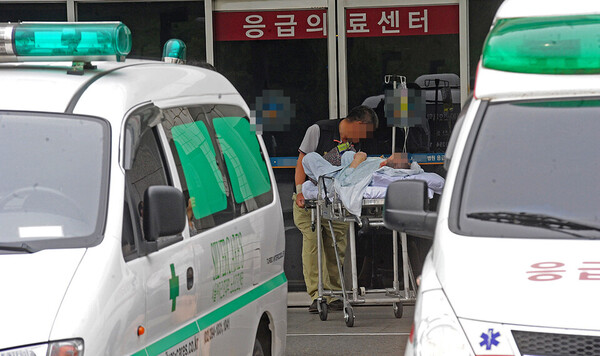To resolve the recurring issue of patients being bounced around between emergency rooms, an expert called for legislative amendments to grant the 119 Emergency Dispatch Center the authority to select hospitals.
Han Jin-ok, a legislative investigator at the National Assembly Research Service, stated this in a report titled “Issues and Key Points: Guidelines for Notifying Difficulties in Admitting Patients and Measures to Ensure Effectiveness,” published in the “Issues and Key Points” report released on Monday.
The report defines the “ER shuttle” as a situation where an emergency room finds it difficult to admit a patient transported by the 119 ambulance crew, leading to the patient being transferred again.

Han noted that the Emergency Medical Services Act was amended in December 2022 to prohibit refusal or evasion of emergency medical care without justifiable reason, and the Ministry of Health and Welfare distributed the “Standard Guidelines for Notifying Difficulty in Admitting Patients to Emergency Rooms (Guidelines for Notifying Difficulty in Admitting Patients)’ to local governments last year.”
“However, the situation has not improved at all,” Han pointed out.
According to Han, emergency room transfers increased by 1,430 cases in just one year, from 4,227 cases in 2023 to 5,657 cases in 2024. On average, 17 emergency patients per day arrive at emergency rooms after spending over two hours on the streets in 119 ambulances, and the time spent waiting at the scene while searching for a hospital is also increasing. Last year was a period of intense conflict between the medical community and the government over the policy to increase medical school enrollment.
The report proposed that to make the guidelines for difficult-to-admit patients effective, the “Act on 119 Rescue and Ambulance Services (The 119 Act)” must be amended. This would require the Emergency Medical Dispatch Center to select the transfer hospital based on criteria established by the municipal and provincial emergency medical committee when the 119 ambulance team requests hospital selection.
A related bill has also been proposed. Rep. Yang Bu-nam of the Democratic Party of Korea, a member of the National Assembly's Public Administration and Safety Committee, proposed an amendment to the 119 Act in July that would allow 119 emergency medical services or the emergency dispatch center to prioritize selecting the hospital for transporting emergency patients.
To enhance the effectiveness of the ‘difficulty in accepting patients’ notification guidelines'—which require the emergency dispatch center to swiftly select a transfer hospital based on criteria set by the city/provincial emergency medical committee when requested by the 119 ambulance crew—all parties involved must actively consider revising the 119 Act,” the report said.
Under the current 119 Act, the emergency dispatch center is required to guide 119 ambulance crews in providing emergency treatment and direct them to the appropriate hospital.
Han also stated that a legal basis is needed to establish an integrated information system necessary for selecting hospitals for patient transfers. This links the National Fire Agency's ambulance activity logs for each emergency patient, the National Emergency Department Information System (NEDIS), and the Health Insurance Review and Assessment Service (HIRA)'s claim data.
Currently, emergency medical institutions use the “Comprehensive Situation Board (E-GEN),” while 119 ambulance crews utilize the “Emergency Medical Activity Log” and the “Pre-Hospital Emergency Patient Triage Tool (Pre-KTAS).” However, user satisfaction and utilization rates remain low.
Additional improvement measures for normalizing the emergency medical system include addressing the causes of non-admission, such as the lack of specialists and bed shortages. Without addressing these root causes, resolving the issue of emergency room transfers will remain limited, according to the report.
Therefore, it is necessary to expand and support medical institutions, such as “Moonlight Children's Hospital,” nighttime emergency hospitals for children designated by the National Emergency Medical Center (NEMC), which can be utilized at night and on holidays for emergency patient care. Securing spare resources for emergency patient care is also necessary to ensure the smooth operation of emergency medical consultation services through the 119 Emergency Dispatch Center, it said.
“ER shuttling reveals a crisis in the emergency medical system. The ‘confirmation of admission capacity’ stipulated in the Emergency Medical Services Act was distorted into a practice of ‘pre-approval’—verifying availability via phone, such as whether isolation beds were available during the COVID-19 period—and became entrenched amid the medical crisis after 2024,” Han pointed out.
In conclusion, Han said, “The proposed solution of guidelines for notifying patients of admission difficulties is unlikely to work effectively on the ground without addressing the fundamental causes of admission failure, such as bed and staffing shortages. It is necessary to explicitly grant (119 ambulance crews) the authority to decide on transfer hospitals and establish legal grounds for building an integrated information system to ensure the guidelines' effectiveness.”
Related articles
- ‘ER shuttling’ cannot be stopped without separating first aid from final treatment: experts
- Emergency medical system on brink as patient refusals, delays soar
- Chuseok ER shuttling feared as most regions skip mandatory admission rules
- Children’s hospitals call for overhaul of nighttime and holiday care system

